![]()
![]()
![]()
Use LEFT and RIGHT arrow keys to navigate between flashcards;
Use UP and DOWN arrow keys to flip the card;
H to show hint;
A reads text to speech;
46 Cards in this Set
- Front
- Back
|
Giotto De Bondone |
- Worked throughout 1300-1337 - Taught by Cimabue - Pushed boundaries of art because he made things look more realistic at the beginning of 14th century art.
|
|
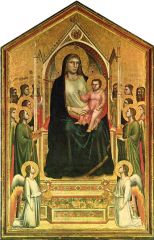
|
Madonna Enthroned, Giotto Di Bondon - Altarpiece for Church of Ognissanti Florence - Giotto really starts to make things look more realistic - Shows more light/shadow/VALUE - More perspective, creates volume - Breaks Medieval tradition - Tempera and Gold on wooden panel |
|
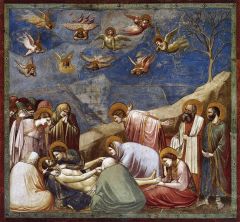
|
Lamentation, Giotto Di Bondone (FRESCO) - At Scrovegni Chapel in Padua - Angels depicted in the background are supposed to coming at you, Giotto uses Foreshortening - Uses value to add mass to figures, shows space by making smaller figures |
|
|
Northern Renaissance art is ______________. |
BRIGHTER. |
|
|
Jan Van Eyck |
Northern Renaissance painter - Made art through 1420-1441 - Brilliant Oil glazes/ he was credited w/"invention" of oil painting - Educated Artist |
|
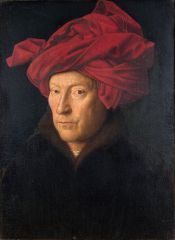
|
Man in a Red Turban, Jan Van Eyck - Oil, Realistic painting instead of Idealistic - Eyes look into viewer, HEAVY detail, RICH reds - Said to be a self-portrait
|
|
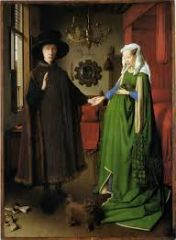
|
Giovanni Arnolfini And His Wife, Jan Van Eyck - Has a long history of where it's been/who owned it: CURRENTLY IN LONDON - Wife looks pregnant: FIRST wife - LOTS of disguised symbolism: Shoes: his dominance DOG: loyalty WHITE Veil: She is a wife - Setting: Bedroom chamber, almost looks like marriage ceremony - Mirror in back is HEAVILY DETAILED: PASSION&REFLECTION |
|

|
Ghent Altarpiece; Adoration of the Lambs, Jan Van Eyck - Annunciation Scene - Iconic piece not an actual narrative piece - Mary/John the Baptist/Jesus in very RICH clothing shown as royalty instead of prophets - Adoration of Lambs: Left: Old Testament Patriarchs Right: New Testament apostales - For San Bavo Cathedral |
|

|
Deposition, Rogier Van Der Weyden - Odd shape conforms to church it was in - More contemporarily dressed so they're relatable - Mary's body copies Jesus' to imitate her pain. - John looks like hes refraining from crying - Skull is present to depict present death - Deposition- Taking Christ's body off cross. |
|
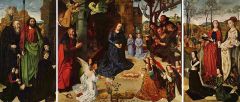
|
Portinari Altarpiece, Hugo Van Der Goes - Narrative piece in a sense but not fully because of background - Birth/Nativity Scene - Everyone is depicted with hands in prayer - NORTHERN PAINTING: Northern symbols - Shepherds are shown as more hard working - For a church in Florence so he shows his success
|
|
|
15TH CENTURY RENAISSANCE ART IN ITALY shows more _______________. |
HUMANISM. |
|
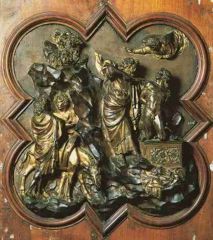
|
Sacrifice of Isaac, Lorenzo Ghiberti - Put in a competition for the Gates of Paradise@ Baptistery of St. Giovanni, Florence - He lost against Brunelleschi
|
|
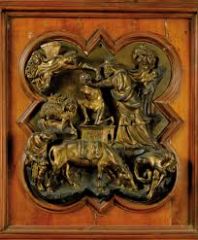
|
Sacrifice of Isaac, Brunelleschi - He used less bronze so it was cheaper; HE WON - Gates of Paradise @ Baptistery of St. Giovanni in Florence |
|
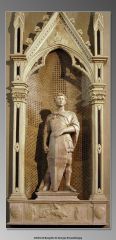
|
St. George, Donatello - Donatello c. 1386-1466 - More realistic sculpture, absorbed lessons of Greeks/Romans and show space - Contrapposto - Linear Perspective |
|
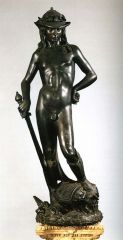
|
David, Donatello - Shows contrapposto - Shows biblical story by presenting his youth and how he defeated Goliath with his faith in god not strength - Bronze -Shows Classical features like heroic nudity
|
|
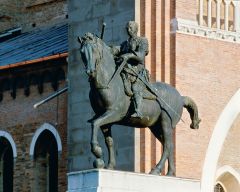
|
Erasmo Da Narni (Gattamelata), Donatello - Equestrian Statue |
|
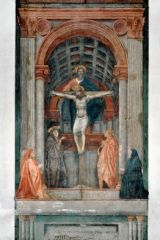
|
Trinity With the Virgin, Masaccio - FRESCO - Linear Perspective; Shows receding space - |
|

|
The Tribute Money, Masaccio - Models light and dark - Shows more linear&ATMOSPHERIC perspective - FRESCO in Florence - |
|
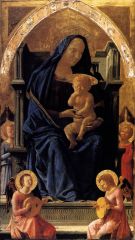
|
Madonna Enthroned, Masaccio |
|
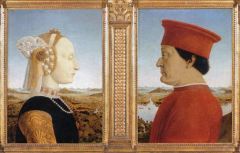
|
Duke and Duchess of Urbino, Piero Della Francesca - OIL on Wood Panel - c. 1474 |
|
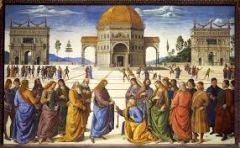
|
Christ Handing Keys to St. Peter, Perugino - @ Sistine Chapel - Shows Roman architectural importance/influence - Important scene
|
|

|
Birth of Venus, Sandro Botticelli - For the Medici Family - Tempera/Gold on Canvas - Very Linear doesn't give much depth
|
|
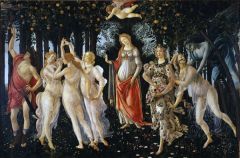
|
Primavera, Botticelli - Merges Virgin Mary with Idea of Venus - Merges Classical themes with Christianity - Commissioner: Medici family - c. 1482 |
|
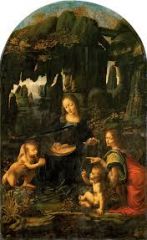
|
Virgin of the Rocks, Leonardo Da Vinci - Shows Da Vinci's interest in geology with detail on rocks - Nativity scene: Mary with Jesus - Chiaroscuro: high contrast between light/dark - Sfumato: the shading is smoky |
|
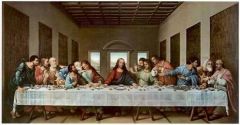
|
The Last Supper, Leonardo Da Vinci - Used tempra paint for FRESCO - Jesus says: "One of you will betray me" scene - Perspective center in painting is Christ - Mathematical precise painting - GREAT COMPOSITION - Mary Magdeline is confused in pic for John the Beloved |
|
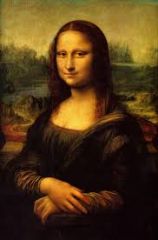
|
Mona Lisa, Leonardo Da Vinci - "La Gioconda" in Europe - Portrait of Lisa Ghiradini/Gioconda - Sfumato - hazy background - Buried with Da Vinci - Wearing a transparent veil - Life painting beyond its lifetime and Da Vinci's |
|

|
Cartoon for Virgin and St. Anne, Leonardo Da Vinci - St. Anne is Virgin Mary's mother - "cartoon" refers to full scale repertory depiction |
|
|
"_______________ depicted the human form"
- Sofonisba Anguissola |
Michelangelo - Had a BIG EGO so he was hard to work with. - Primarily a sculptor, comes from Florentine family
|
|

|
Pieta, Michelangelo - Mary holding her son Jesus in St. Peters basilica - Commission was from a French cardinal @ the Vatican - Behind bulletproof windows - Mary is shown as very young/beautiful - Heavy classical/Greek influence - Anatomy is really perfect in this sculpture. |
|
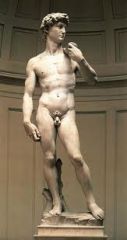
|
David, Michelangelo c. 1501-1504 - 17' ft tall and ankles are weak but made of marble; VERY UNPROPORTIONED - Merged the idealistic view of him w/the religious righteous view of him - Moment before he is about to kill Goliath - Commissioned by City of Florence for Cathedral |
|
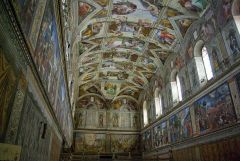
|
Sistine Chapel Paintings, Michelangelo - North Wall: Life of Christ - South Wall: Life of Moses - Divides space with delusional architectural images - Didn't make the paintings laying down - Julius the 2nd was the patron for the painting - Vaulted room; 3 leveled paintings |
|
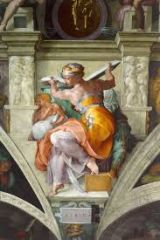
|
Libyan Sibyl, Michelangelo - FRESCO painting - Example of the difficult poses he would set for himself - Painting process: He wouldn't make a copy and one FINAL he'd just do the final
|
|
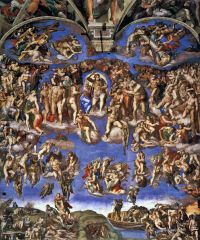
|
The Last Judgement, Michelangelo - made 30 yrs after sibyl paintins - People are proportioned differently: more heavy - Oppressing feel to painting - Jesus' hand is up in condemnation |
|
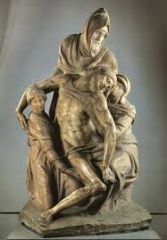
|
Florence Pieta, Michelangelo - Made more by the time of his death - Talks more about religion than idealism |
|
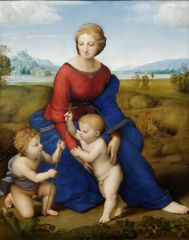
|
Madonna of the Meadow, Raphael Sanzio - Not as innovative as Da Vinci/Michelangelo - Creates work that is graceful not dramatic - Anatomy of humans is better, better use of color, composition, skin tone of softer - He is prosperous because of his technical, non-dramatic, and idealistic skill. |
|
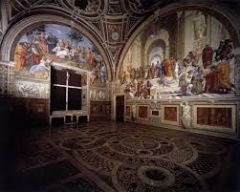
|
Stanza Della Segnatura, Raphael - Room designed for the Pope - 4 Rooms/Walls: Law, Theology, Poetry, Philosophy - Room Disputa/Theology: scene of discussion of Euchrist - Room Cardinal Virtues/Law - Room Parnassus/Poetry: Apollo is playing the flute |
|
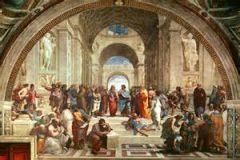
scene is in the Vatican |
School of Athens, Raphael - Commissioner: Julius the Second for Philosophy - In the center is Aristotle and Plato who are talking w/ opposing gestures - Philosophers shown: Socrates, Heroclites, Diagones, Apollo&Athena - Epitome painting of the Renaissance Era but it idolizes the classical era. Shows the admiration of knowledge and Expansion, |
|
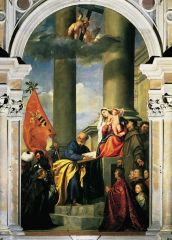
|
Pesaro Madonna, Titian - Patron was Jacopo Pesaro - Religious image commemorating a special event in patron's life - Family members depicted in the right side - Lots of diagonal perspective which is new. - More chaotic tone/more innovative - REFORMATION SCENE: Counter scene that exphasizes importance of church |
|
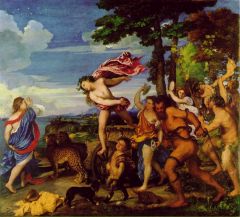
|
Meeting with Bracchus and Ariadne, Titian - Strictly based on greek myth: REVIVING of that - Very unrealistic/awkward/ungraceful leap - Laocoon is even depicted with snakes - Based on MANY Classical Greek sculptures - Great transition from a dark side to light side - Dionysis' constellation is shown even though its it's day. More symbolic piece than anything. |
|
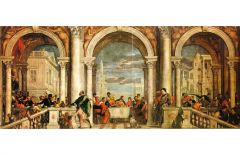
|
Feast in the House of Levi, Veronese - Last supper scene but more of a landscape drawing then DaVinci's inside Last Supper - Veronese has a good sense of perspective. - There is less of a focus on Jesus though he is centered - Busy painting: No real religious affiliation though its a religious painting |
|
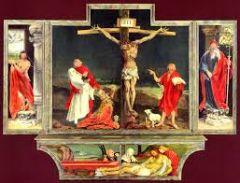
|
Isenheim Altarpiecec, Matthias Grunewald - For a church that was also a monestary - Trying to give the idea that "Christ knows when you're suffering" - Their pain is depicted in a way to imitate the sick in the hospital |
|

|
Self-Portrait, Albrecht Duhrer - Very Christ-Like painting - Microscopic detail - Lived/Worked during age of Discovery: science printmaking, inventions |
|
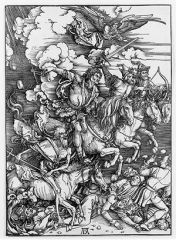
|
Four Horsemen of the Apocolypse, Albrecht Duhrer - FIRST printmade piece of art - NORTHERN Painting: his prints spread throughout - REFORMATION PIECE - From Book of Revelation - Bishop being trampled by horse which is an illusion for reformation taking place |
|
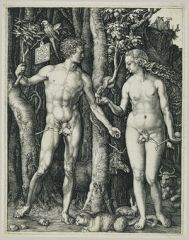
|
Adam and Eve, Albrecht Duhrer - Duhrer goes to Italy and is influenced heavily by classical mythology and Venus. - Shows merging with Northern and and Classical art - Elk represents: melancholi-ness Ox: Laziness - 2 Different Print Processes: 1. Engraving W/Metal Intalgio 2. Woodcut(Relief) |
|

|
Four Apostales, Albrecht Duhrer - Painting of John the Beloved, Mark, Peter and Paul - Very interestingly composed - John and Paul (New Testament Apostle) are in front: REFORMATION - Given to city of Nuremburg |
|
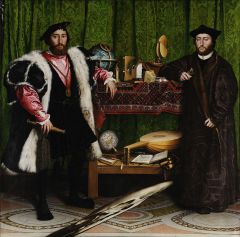
|
The Ambassadors, Hans Holbein - Jean de Dintevile and Georges de Selves (Bishop of Lavaur) COMMISSIONERS - Instruments are carefully chosen: Celestial Globe, Tapedum, Sundial,ALL MEASURED TIME - Skull being depicted in distortion - Henry the 8th there -During this time they were at the edge of scientific advancement |

